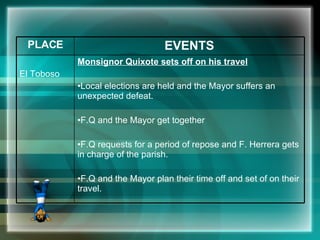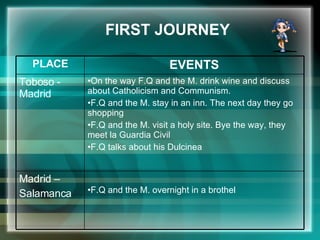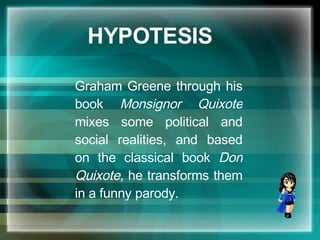M Onsignor Quixote
- 1. Presented by: Gineth Mogollón Jessica Mancera Laura Noguera Ana Maria Guzmán Catalina Caro
- 2. OUTLINE Biography Background Plot Theories 4.1. Lectura política de la novela (Jacques leenhardt) 4.1.1. Communism 4.1.2 Catholicism 4.2. Parody (Gerard genette) 5. Hypothesis 6. Bibliography
- 3. GRAHAM GREENE 1904 Berkhamsted – 1991 Vevey
- 4. During his childhood, he had a hard life, due to he studied in a boarding school. He became a melancholy boy. For this period, his family was very famous; due to, the economical and social power they had. In addition to being novelist, he was journalist, so, during a long time he worked to THE TIMES as sub publisher. He worked as an agent to the secret English service. His best friend was a Spanish priest called Leopardo Durán.
- 5. NOVELS
- 6. BACKGROUND THE SPANISH CIVIL WAR (1936-1939) 1936 to 1939 : A military rising originating in Morocco, headed by General Francisco Franco, spreads rapidly all over the country, thus starting the Spanish Civil War. 1939 to 1945 : Spain stays out of the 2nd World War. 1947: Franco announces the restoration of the monarchy when he dies or retires (Law of Succession).
- 7. 1953: Spain and the US sign a co-operation agreement providing for the establishment of bases for joint use. 1955: An agreement between the US and the Soviet Union enables Spain to enter the United Nations with other fifteen nations. General Franco dies (November 20th). King Juan Carlos takes the oath as King of Spain at a joint session of the Cortes and the Council of the Realm. A chapter of Spanish history was forever closed and the doors of freedom and hope were opened for the Spanish people.
- 8. PLOT CHARACTERS Monsignor Quixote Teresa: housekeeper Enrique Zancas: Sancho Bishop Bishop of Motopo Father Herrera Guardia Civil The robber Don Diego Father Jose Father Leopoldo Father Enrique, F. Francisco, F. Felipe Professor Pilbeam Thérèse de Lisieux: Dulcinea
- 9. Father Quixote becomes a Monsignor F.Q. sets off to the town in his SEAT 600 and meets the bishop of Motopo. F.Q invites him to have lunch and fixes his car. The bishop comes back to Motopo. F.Q. gets a letter from the bishop. The Holy Father promotes him to the rank of Monsignor. El Toboso EVENTS PLACE
- 10. Monsignor Quixote sets off on his travel Local elections are held and the Mayor suffers an unexpected defeat. F.Q and the Mayor get together F.Q requests for a period of repose and F. Herrera gets in charge of the parish. F.Q and the Mayor plan their time off and set of on their travel. El Toboso EVENTS PLACE
- 11. FIRST JOURNEY On the way F.Q and the M. drink wine and discuss about Catholicism and Communism. F.Q and the M. stay in an inn. The next day they go shopping F.Q and the M. visit a holy site. Bye the way, they meet la Guardia Civil F.Q talks about his Dulcinea Toboso - Madrid F.Q and the M. overnight in a brothel Madrid – Salamanca EVENTS PLACE
- 12. F.Q hide a fugitive from justice F.Q and the M. plan to go to Osera Halfway between Valladolid and Osera F.Q and S. get drunk. F.Q disappears By the way … F.Q has a curious encounter; confession in a bathroom. F.Q watches a strange movie ( Maiden’s prayer) Valladolid EVENTS PLACE
- 13. F.Q and S. meet Señor Diego and F. Jose F.Q and S. go an estrange celebration. F.Q is chase by la Guardia Civil Rosinante crash into a monastery F.Q dies Osera M.Q becomes a prisoner S. transformes Rosinante and rescues F.Q M.Q and S. start their second journey El Toboso EVENTS PLACE
- 14. Lectura Política de la Novela (Jacques leenhardt) Two ideological Systems : Socialism Fascism The two ideologies are developed in the book. Coherent significant structure: the tale is intelligible through Lon NL. Ideological insertion: Bourgeois and proletarians problems. Ideology and social class : Relation of social structure with a social class. Social class functions : historical context that influences in the characterization of the novel.
- 15. Socialism = Marx Proletarians = Major = Town Fascism = Franco = Bourgeois = Church Church = Quixote = Town They demystify beliefs that can be taken practices to it
- 16. Marxism: A political movement developed by Karl Marx who based his though on Hegel. It contains three different aspects: Marxism: materialism and economically balance between social classes. Socialism: negation phase against to the capital system and the production system. Communism: last phase in the process, it shows the classes’ freedom and equality
- 17. Communism as the principal political movement in the story. The mayor (Sancho) as the principal communist character. Opposition between fascism and communism Contradiction in the mayor though and his action. Communism just as an illusion of the reality.
- 18. Eurocommunism It was a current among the Communist Parties, mainly in Europe, from 1968 up to the early 1980s, which sought autonomy of their own national parties relative to the leadership claims of the Soviet and Chinese parties or each other, being particularly critical of the lack of internal democracy in the Communist movement.
- 19. CATHOLICISM Graham Greene become catholic at his age of 22 and it got strength with experiences and reflections. Monsignor Quixote is the catholic representation of Greene’s religious thinking, doubts, and controversies about the church position. Through the book he develops the faith as an important value. The trips of Greene and the father Durán over Spain. Graham Greene and the Catholicism
- 20. Franco and the Catholicism Catholicism became the state religion in 1851. After the civil war in Spain(1936-1939) Franco took over as dictator. His dictatorship held close relations with the Catholic Church. During the Franco years, Roman Catholicism was the only religion to have legal status. Franco regime saw the restoration of the church's privileges .
- 21. At this time church and state of Spain were one body. Franco was given a special power from the Vatican . He outlawed anything that did not agree with catholic beliefs. The Second Vatican Council in favour of the separation of church and state in 1965 attempted to reform the church in Spain.
- 22. GERARD GENETTE PALIMPSEST, LITERATURE IN THE SECOND GRADE (1982) Some concepts are very important to take into account into the novel: Palimpsest: Across a text, we can see many texts, reflected into the first one. INTERTEXTUALITY= TRANSTEXTUALITY It is related to the things which the text demonstrate impliedly or explicitly. Parody: It imitates the argument but at the same time the aesthetics is changed.
- 23. PARODY IN MONSIGNOR QUIXOTE Names : Quixote, Sancho, Rosinante and Dulcinea Places: La Mancha, brothel Things: windmills, novels States: madness, ignorance Relationship between F.Q and S.
- 24. “ You have become a knight. We must find your sword, your spurs, your helmet –even if it is only a barber’s basin” “ We are going into battle, Sancho. I need my armor. Even if it is as absurd as Manbrino’s helmet ” “ In a certain village in La Mancha which i do not wish name” Monsignor Quixote – Don Quijote
- 25. “ The proletarian is without property; his relation to his wife and children has no longer anything in common with the bourgeois family relations; modern industrial labor has stripped him of every trace of national character” “ The bourgeoisie has put an end to all feudal, patriarchal, idyllic relations … it has drowned the most heavenly ecstasies of religious fervour, of chivalrous enthusiasm in the icy water of egotistical calculation” Monsignor Quixote – The Communist Manifest.
- 26. HYPOTESIS Graham Greene through his book Monsignor Quixote mixes some political and social realities, and based on the classical book Don Quixote, he transforms them in a funny parody.
- 27. BIBLIOGRAPHY GENETTE, Gérard. Palimsestos. translated by C. Newmann and C. Doubinsky (Lincoln: University of Nebraska Press, 1997 GREENE, Graham. Monsignor Quixote . WSP Publishers. USA 1982 LEENHARDT, Jacques . Lectura Política De La Novela. Siglo Veintiuno Editores. España. 1975


























